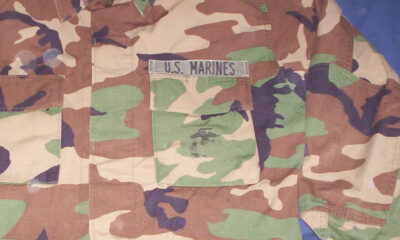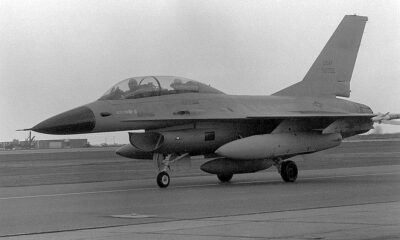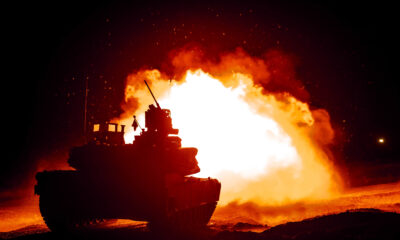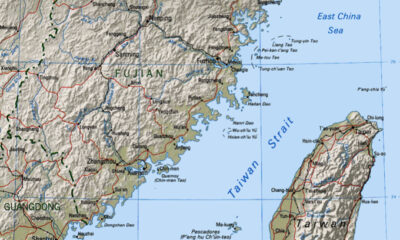Civilization
My Lessons Learned From the Ukraine War
A soldier fighting in (and for) Ukraine testifies that NATO training of Ukrainian troops is poor, and unsuited to the type of warfare.

In August 2022, I became a rifleman in an infantry battalion of the Ukrainian Armed Forces (Zbroyny Sily Ukrainy, ZSU). Over the course of the following year, I would spend a total of ten months fighting with the unit on the front lines in the Kharkiv, Donetsk, and Luhansk Oblasts. Before joining the ZSU, I had been a Ph.D. student in political science and before that an officer in the Armed Forces of the Slovak Republic. My time in the trenches gave me certain insights into the war that, I hope, might be useful to readers who want to gain a better understanding of the most important armed conflict of our lifetimes. They might also be interesting to those who want to help NATO militaries better prepare for future conflicts.
The inspiration for this article arose from a number of conversations and seminars I held with military professionals from NATO countries after my return from Ukraine. It focuses on three areas that I was repeatedly asked about during these conversations. Of course, it is based on my personal observations of a limited segment in a huge war. That said, based on what I have read and heard from others, I have not included anything that I have reason to believe is not generally true of the entire conflict.
Although my criticism of the ZSU can, at times, seem trenchant, everything I say comes from a place of love. I am very grateful that I had the opportunity to serve in the ZSU. I have nothing but admiration for the pure grit of Ukrainian soldiers, which is the primary factor that has prevented the Russian invasion from achieving its aims. I will also not pretend to be a neutral observer of the Ukraine War. Quite frankly, I am disgusted that an authoritarian state can invade a democratic one in twenty-first-century Europe.
Infantry Tactics
Media reports, as well as a number of my former NATO colleagues who train Ukrainian forces, have told me that Ukrainian infantry training with NATO often complain that the training they receive is not relevant to the Ukrainian battlefield. NATO tactics place emphasis on movement, while the war in Ukraine has descended into a stagnant conflict characterized by trenches and immobile front lines. Such staples of NATO small-unit tactics like patrolling, infiltration, ambushes, and raids are hardly used in Ukraine.
With a few exceptions (like the well-publicized battle of Bakhmut), most of the conflict along the 1000-km front line takes place in rural areas, so close-quarters battle and the tactics of military operations in urban terrain are also said to be useless. In most areas of this rural front, it is difficult for infantry to even approach enemy positions. Over the two years of mostly static conflict, these positions have been set up precisely to prevent that from happening. Trenches and bunkers with overlapping fields of fire, supported by minefields, make infantry operations difficult. When infantry comes into contact with the enemy, the most common type of tactical maneuver is the storming of trenches.
All that is true, with caveats. Despite the experience of two years of war, the tactical skills of the vast majority of Ukrainian forces that I observed are poor. Most soldiers are sent to the front line with practically no training in infantry tactics. This results in absurd and dangerous situations, like what happened regularly in my company when we were sent on our regular rotations on the front line. We would ride to the vehicle drop-off point, sometimes as many as thirty soldiers, on top of a BTR or an MT-LB. At the vehicle drop-off, we would all stand around for up to ten minutes, slowly unloading equipment and supplies. Carrying heavy loads, soldiers would slowly trickle forward to their positions in random groups of one, two, or more, often using white light to navigate treacherous tree lines. All of this occurred well within earshot of the nearest Russian position less than 500 meters away.
In a situation like this, any tactical training – whether immediately relevant or not – would be an improvement. At the very least, it would help soldiers develop a tactical mindset and reduce the risks associated with concentrations of soldiers, as well as individual soldiers getting lost or injured without anyone noticing for some time. In terms of tactics that are specifically useful on the Ukrainian front, classic NATO battle drills, e.g., knocking out bunkers, are still highly relevant, but they cannot be taught without at least some familiarity with the basics of tactical movement.
Though most of the combat occurs in rural areas, close-quarters battle can be applied beyond its original context, precisely in the storming of Russian trenches and fortifications. Many Russian trench lines have become highly sophisticated, with long networks of passages, often covered, and bunkers consisting of multiple rooms. In other words, Russian trenches now resemble the interior of buildings, and successfully storming them is no longer a simple drill.
Drones
Drone warfare in the Ukraine War has received much attention and even casual observers have concluded that drones will be crucial in any future conflict. For a few months, I worked as a drone operator in my platoon, providing me with some insights into this specific type of operation.
First of all, to win any future wars, drones will be necessary. But to ensure bare survival on the battlefield, never mind winning, anti-drone capabilities will be crucial. Any movement of troops is already extremely difficult on the drone-infested front line in Ukraine. Troops are constantly exposed to attacks by armed drones that are more accurate, though usually less powerful, than artillery. Any unconcealed troops will quickly be detected and targeted. Hence, any development of drone capabilities must be accompanied by at least equal development of anti-drone capabilities.
On a more positive note, for defenders, despite the much-touted use of cheap, commercial drones, hiding from this type of drone is not too difficult. During the day, at realistic observation distances, such drones can usually only see soldiers if they are moving. The thousands of sexy drone videos that have come out of the Ukraine War notwithstanding, drones can rarely drop below 100m and usually cannot linger directly above their targets. This necessitates observation from a certain standoff distance and at an acute angle. In these situations, a simple but effective protection against drone observation is to stop moving and lie down. Making use of any kind of concealment, even leaning against a tree, is even better. There are, of course, high-end professional drones that have presumably better observation capabilities, but these are, for the time being, rare in Ukraine, and only sophisticated, rich militaries will be able to deploy them in large numbers in the near future.
During my time in Ukraine, my battalion decided that drones should be deployed as close to the front line as possible, within front-line platoons. This is why several members of each platoon, including myself, were selected to train as drone operators. Obviously, one of the reasons for this was to give infantry platoons flexibility in the use of drones. If we saw something suspicious in front of our position, we could immediately deploy the drone to investigate the threat without having to request support or explain on the radio what the drone operators were looking for.
There was, however, another reason why it was advantageous to put drone operators as close to the front line as possible. In our sector of the front, radio signals in the airspace above the Russian positions were permanently and effectively jammed by Russian electronic warfare systems. Flying drones above the Russian positions was difficult because the connection between the drone and control panel was unreliable. It was, therefore, advantageous to put the drone operator as close to the drone as possible, resulting in a stronger signal connecting the drone to the operator. In other words, putting the drone operator on the front line was supposed to allow us to fly further toward Russian positions and maintain better situational awareness. Generally, in future conflicts, it seems that in similar conditions of intense jamming, drone operators will have to move closer to the front line. This might include the operators of not only small tactical drones, but also of larger, more sophisticated systems.
Finally, during my time as a drone operator in Ukraine, I realized that drones must be treated as disposable assets. My company lost a drone, by very rough estimate, about once a month. Treating drones as disposable will, however, requires a major mindset change in NATO militaries. In my time in the Slovak Armed Forces, drones were treated as highly sensitive and specialized assets, even the relatively inexpensive commercial ones. Only select personnel could operate them, there were never enough, there was always a cumbersome bureaucratic process for their deployment, and the main concern in any drone operations was getting the drone back in one piece. With this mindset, the Ukrainian military would have long been screwed.
TLPs, MDMP, CONOPS, Load plans, CASEVAC plans, PowerPoint, whiteboards, briefings…it’s all necessary
On a particularly unpleasant day during the Battle of Lyman in the fall of 2022, about twenty out of the fifty members of my company were killed or injured during an eight-hour period (I was one of them). The first batch of casualties was promptly evacuated by a light armored vehicle belonging to the company. Those injured after the first evacuation were less fortunate. No vehicle was available to perform the evacuation. A colleague had shrapnel wounds to his inner thigh, and we were worried that he was bleeding internally from his femoral artery into the cavity between his thigh muscles. He had to wait two hours for an evacuation. Fortunately, his bleeding was not as serious as we had feared, and he made a full recovery. If his femoral artery had, indeed, been hit, he would have been dead long before he had been taken off the battlefield. Others did die that day, though in those cases, faster evacuation would not have saved them.
How is it possible that the company’s vehicles -which had been available to perform an evacuation just a few minutes previously – had suddenly disappeared and we were left stranded in the field with a seriously wounded soldier and new casualties every few minutes?
It turns out that it was all a planning problem. Prior to the operation, the company had simply not prepared a casualty evacuation (CASEVAC) plan that detailed which vehicle was tasked with evacuating casualties. Hence, after the first evacuation, our light armored vehicle had simply gone off to do other tasks and a different vehicle had to be located.
In less dramatic fashion, one morning I was supposed to ride with a BTR from our base to a position whence I was to fly a drone. The commander of the company’s drone section assured me that the driver would load the drone into the BTR and would be waiting for me outside the building where I was quartered. As I emerged from the building at the specified time, I saw the BTR speeding away in the distance. The driver (who was the company sergeant-major) had simply forgotten me. I knew the route he was going to take, so after an intense run, I was able to head him off at an intersection a few minutes later. Boarding the BTR, I quickly realized he had also forgotten to load the drone. He had set off on his daily tasks quite oblivious that he was supposed to give me a ride.
At that point, I couldn’t help but fondly recall the big whiteboard in the hallway outside my company commander’s office in my former unit in Slovakia. That whiteboard detailed what each of the company’s vehicles was doing on any given day, who was driving it, who was riding in it, and what it was supposed to be carrying. Needless to say, the soldiers, and, secretly, probably a number officers, used to hate that whiteboard, as well as all the interminable meetings, PowerPoint presentations, load plans, CASEVAC plans, Concepts of Operations, and mission planning exercises based on Troop Leading Procedures and the Military Decision Making Process that seemed to take up so much of our time. We were not, after all, idiots. How hard could it be to keep track of a few vehicles, a few boxes of ammunition, or a couple of soldiers?
In light of the events described above, my time in Ukraine gave me a new appreciation for all of these time-wasting bureaucratic tasks, whose main purpose can be summed up as preventing fuck-ups. Unfortunately, the ZSU does not seem to share my enthusiasm for planning, sometimes to the very real detriment of its soldiers and operations. At any given time, most soldiers had only a very hazy idea of the broader situation around them or even of their mission.
Planning was usually limited to crude diagrams and tables scribbled by the platoon commander in ballpoint pen on a piece of notepaper. Though the planning processes developed by NATO militaries can occasionally be a bit time-consuming, they are not complicated. Quite the opposite. They are specifically designed to give soldiers and officers, some of whom may not be the sharpest knives in their respective drawers, a simple, systematic, routine way to avoid preventable problems. You can learn to make a rudimentary CASEVAC plan in fifteen minutes, but in Ukraine, it almost took the life of a soldier for the company command to start thinking about it.
This article was originally published by RealClearDefense and made available via RealClearWire.
Jakub Jajcay is a former officer in the Armed Forces of the Slovak Republic, where he served in a number of elite units. He is currently working on his Ph.D. at the Department of Middle Eastern Studies of Charles University in Prague.
-

 Education4 days ago
Education4 days ago‘Grading for Equity’: Promoting Students by Banning Grades of Zero and Leaving No Class Cut-Ups Behind
-

 Education1 day ago
Education1 day agoCHAPTER 11: Critical Race Theory: A Species of the Ideological Thought Genus Marxism
Space Is No Longer the Final Frontier—Reality Is [forthcoming release May 2024] -

 Family4 days ago
Family4 days agoIdaho defends against abortion mandate
-

 Constitution3 days ago
Constitution3 days agoPresidential immunity question goes to SCOTUS
-

 Civilization5 days ago
Civilization5 days agoNewsom plays silly abortion politics
-

 Civilization23 hours ago
Civilization23 hours agoWill Trump flip New York?
-

 Civilization3 days ago
Civilization3 days agoMarine Corps Force Design: In Defense of Chowder II
-

 Clergy1 day ago
Clergy1 day agoHistorical Points Have Their Place, But That Is Not Where Your Faith Is To Stand!












